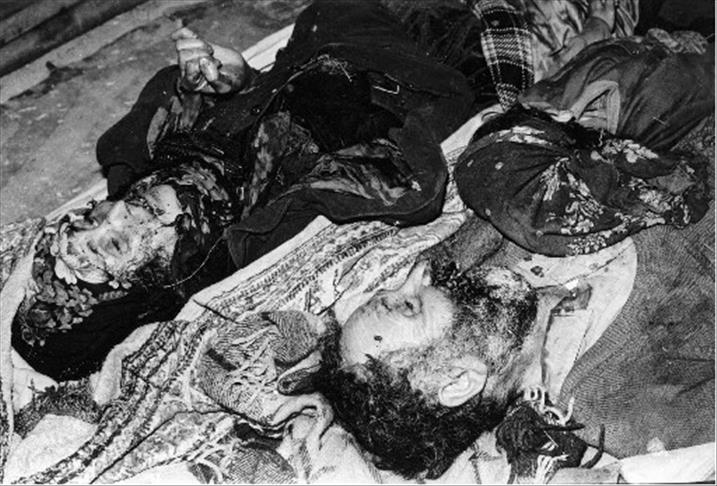
Turkey's ambassador to Azerbaijan, Ismail Alper Coskun, said Tuesday that Ankara would make every effort to remind the world of the Khojaly massacre that occurred during the Nagorno-Karabakh War.
During a ceremony Tuesday held at the Turkish Embassy in Baku on the 22nd anniversary of the massacre, Coskun said the incident is commemorated in Turkey in honor of those who died.
"Together with Azerbaijan, we will continue to tell the whole world what happened in Khojaly," he said.
"Despite the indisputable facts and victims’ statements, the world still ignores what happened," Coskun said.
Coskun reiterated that Turkey and Azerbaijan will continue to actively raise awareness in the international community by presenting the historical facts of the massacre. He also said Turkey would always stand alongside Azerbaijan.
The ceremony was also attended by Turkish Republic of Northern Cyprus (TRNC) envoy to Azerbaijan Sadettin Topukcu, Azeri lawmakers, scientists, Turkish businesspeople and several other guests.
- The fall of Khojaly
Khojaly, a town with a population of 11,356 at the start of the war, fell to Armenian forces following the capture of the region’s capital, Khankendi.
In January 1992, Armenia took control of the villages and roads around Khojaly and besieged the town.
Cut off from both outside aid and power supplies, the town was accessible only by helicopter. On January 28, 1992 a transport helicopter travelling between the cities of Shusha and Agdam was shot down by Armenian anti-aircraft fire, killing the 44 civilians onboard.
Khojaly defenses consisted of only lightly armed local defense forces and a small number of Azeri soldiers.
On February 25, Armenian forces launched an offensive with heavy equipment and personnel provided by the 366th CIS Infantry Regiment.
After almost two hours of artillery and tank shelling, a total of 613 civilian Azeri citizens were killed, 487 critically wounded. Armenian forces took 1,275 prisoners, including 150 who still remain unaccounted for.
The Khojaly massacre was described by Human Rights Watch as "the largest massacre to date in the conflict over the disputed territory of Nagorno-Karabakh."
It is recognized as a massacre by the governments of Azerbaijan, Canada, Mexico, Colombia, Peru, Pakistan, Bosnia and Herzegovina, Romania, Czech Republic, Honduras, Jordan and the Parliamentary Assembly of the Organization of Islamic Cooperation (OIC).
It is also recognized by US state governments in Massachusetts, Texas, New Jersey, Georgia, Maine, New Mexico, Arkansas, Oklahoma, Tennessee, Pennsylvania, West Virginia, Connecticut and Florida.
In January 2005, PACE Resolution 1416 titled, “The conflict over the Nagorno-Karabakh region dealt with by the OSCE Minsk Conference,” was signed by 31 members of the assembly.
The resolution says, “Considerable parts of Azerbaijan’s territory are still occupied by Armenia, while separatist forces continue to control the whole of the Nagorno-Karabakh Region. The widespread ethnic hostilities that preceded it led to large-scale ethnic expulsions and the creation of mono-ethnic areas that resemble ethnic cleansing."
Several memorials and museums have been built in memory of the victims in The Hague, Copenhagen, Ankara, Budapest, Sarajevo and Mexico City.
The world’s first museum dedicated specifically to the massacre is located in Kocaeli, Turkey.
Azerbaijan and Armenia fought a brutal three year war over the landlocked Nagorno-Karabakh region in 1991-1994, following the collapse of the Soviet Union.
By the end of the war, Armenian separatist forces had captured approximately 14% of Azerbaijan’s territory.
A Russian-brokered cease fire was signed in May 1994. Peace talks, mediated by the OSCE Minsk Group, have been ongoing ever since.
englishnews@aa.com.tr


